Cloud-Based Approach to Autism Interventions: Dissertation Proposal
VerifiedAdded on 2023/05/30
|9
|1961
|210
Report
AI Summary
This dissertation proposal interim report explores the potential of a cloud-based approach to autism interventions, addressing the increasing prevalence of Autism Spectrum Disorders (ASD) and the fragmented nature of current Information and Communications Technology (ICT) solutions. The report highlights the limitations of existing applications like Pocket PC Picture Exchange Communication System (PECS) and Let’s Talk Voice Output Communications Aid (VOCA), which focus on specific aspects of ASD. It suggests a cloud-based platform that integrates various functions, including digital libraries, virtual reality (VR), and artificial intelligence (AR), to enhance accessibility and provide a comprehensive learning environment for autistic children. The methodology involves primary research through focus groups with Computer Science and Psychology professionals, followed by design, development, testing, and evaluation of the proposed application, drawing inspiration from search engine frameworks and content-based image retrieval (CBIR) techniques.
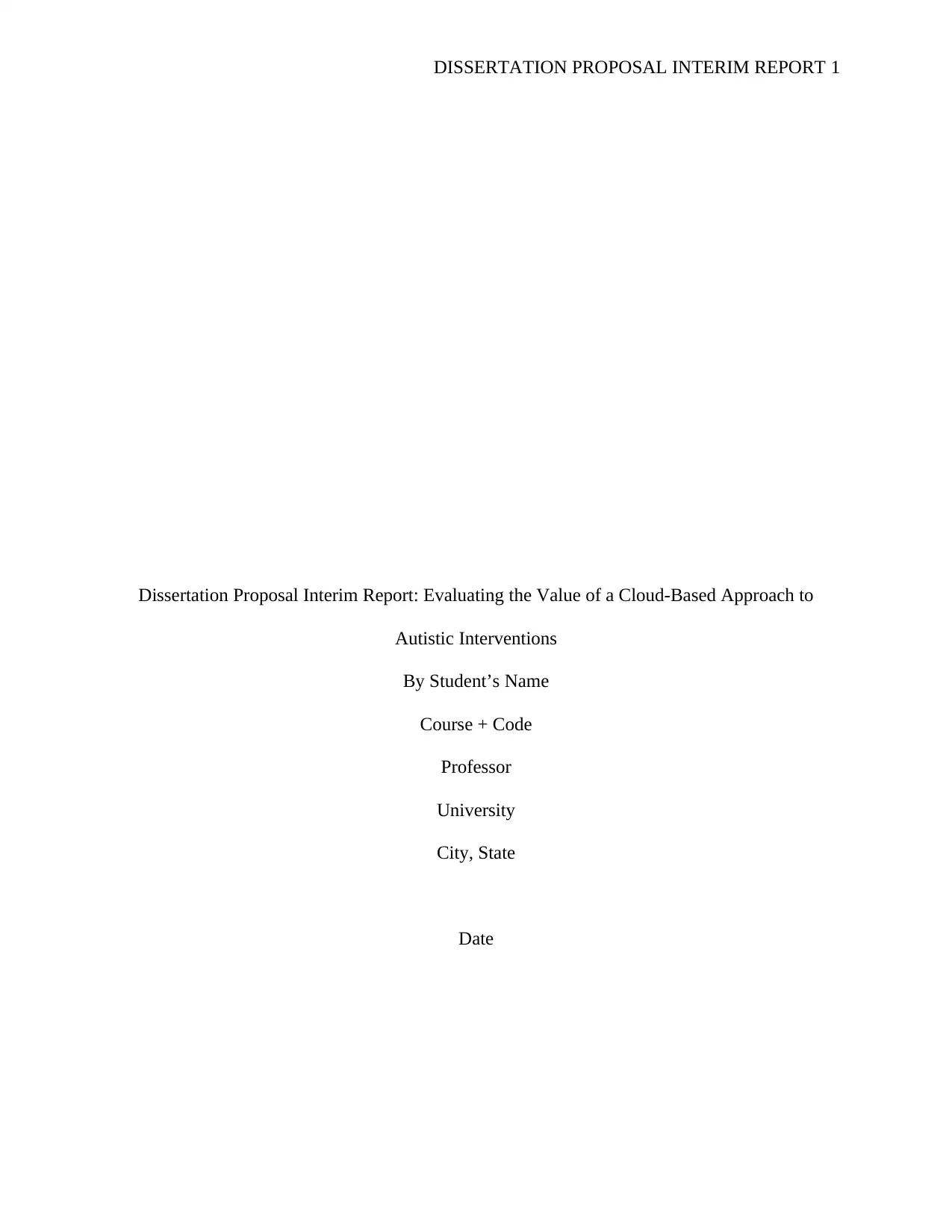
DISSERTATION PROPOSAL INTERIM REPORT 1
Dissertation Proposal Interim Report: Evaluating the Value of a Cloud-Based Approach to
Autistic Interventions
By Student’s Name
Course + Code
Professor
University
City, State
Date
Dissertation Proposal Interim Report: Evaluating the Value of a Cloud-Based Approach to
Autistic Interventions
By Student’s Name
Course + Code
Professor
University
City, State
Date
Paraphrase This Document
Need a fresh take? Get an instant paraphrase of this document with our AI Paraphraser
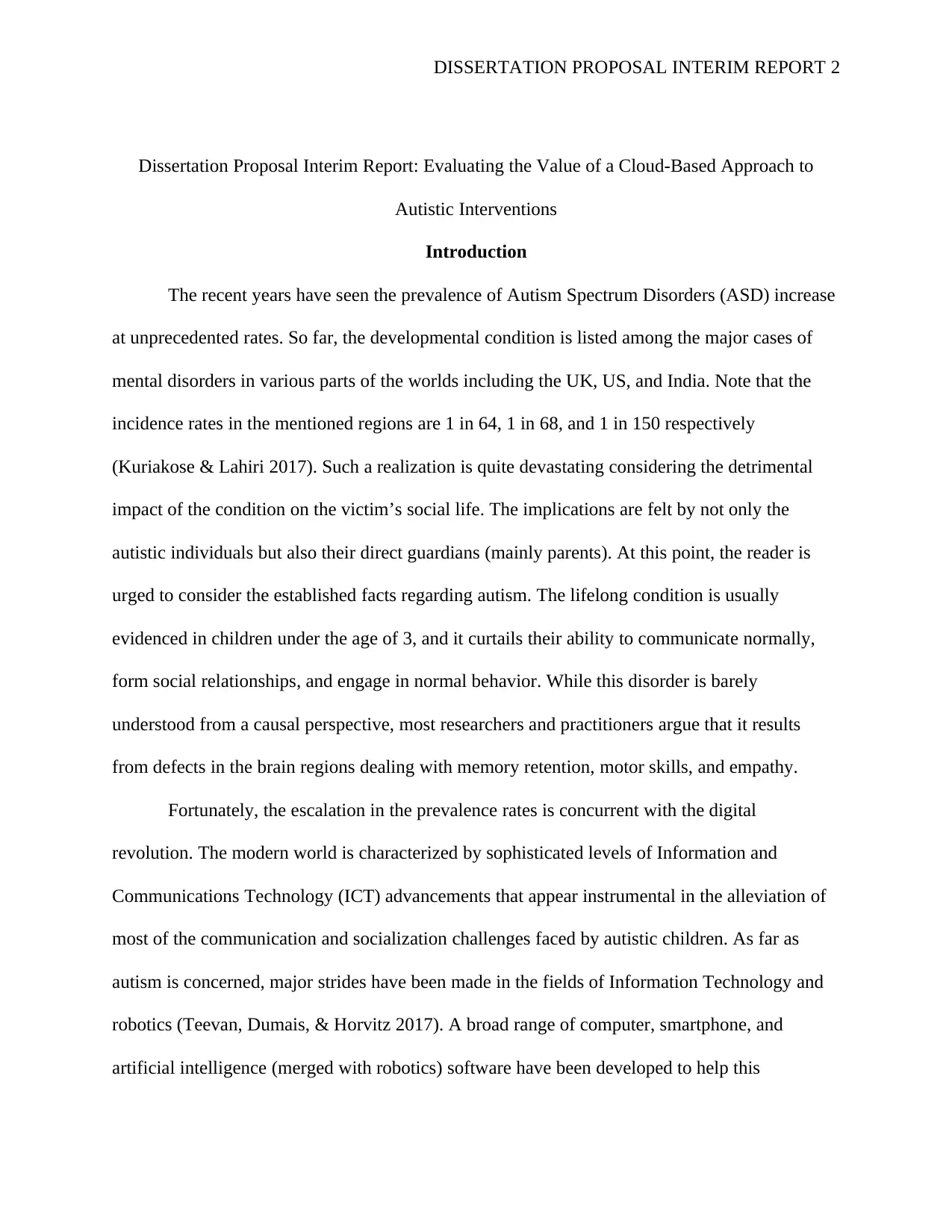
DISSERTATION PROPOSAL INTERIM REPORT 2
Dissertation Proposal Interim Report: Evaluating the Value of a Cloud-Based Approach to
Autistic Interventions
Introduction
The recent years have seen the prevalence of Autism Spectrum Disorders (ASD) increase
at unprecedented rates. So far, the developmental condition is listed among the major cases of
mental disorders in various parts of the worlds including the UK, US, and India. Note that the
incidence rates in the mentioned regions are 1 in 64, 1 in 68, and 1 in 150 respectively
(Kuriakose & Lahiri 2017). Such a realization is quite devastating considering the detrimental
impact of the condition on the victim’s social life. The implications are felt by not only the
autistic individuals but also their direct guardians (mainly parents). At this point, the reader is
urged to consider the established facts regarding autism. The lifelong condition is usually
evidenced in children under the age of 3, and it curtails their ability to communicate normally,
form social relationships, and engage in normal behavior. While this disorder is barely
understood from a causal perspective, most researchers and practitioners argue that it results
from defects in the brain regions dealing with memory retention, motor skills, and empathy.
Fortunately, the escalation in the prevalence rates is concurrent with the digital
revolution. The modern world is characterized by sophisticated levels of Information and
Communications Technology (ICT) advancements that appear instrumental in the alleviation of
most of the communication and socialization challenges faced by autistic children. As far as
autism is concerned, major strides have been made in the fields of Information Technology and
robotics (Teevan, Dumais, & Horvitz 2017). A broad range of computer, smartphone, and
artificial intelligence (merged with robotics) software have been developed to help this
Dissertation Proposal Interim Report: Evaluating the Value of a Cloud-Based Approach to
Autistic Interventions
Introduction
The recent years have seen the prevalence of Autism Spectrum Disorders (ASD) increase
at unprecedented rates. So far, the developmental condition is listed among the major cases of
mental disorders in various parts of the worlds including the UK, US, and India. Note that the
incidence rates in the mentioned regions are 1 in 64, 1 in 68, and 1 in 150 respectively
(Kuriakose & Lahiri 2017). Such a realization is quite devastating considering the detrimental
impact of the condition on the victim’s social life. The implications are felt by not only the
autistic individuals but also their direct guardians (mainly parents). At this point, the reader is
urged to consider the established facts regarding autism. The lifelong condition is usually
evidenced in children under the age of 3, and it curtails their ability to communicate normally,
form social relationships, and engage in normal behavior. While this disorder is barely
understood from a causal perspective, most researchers and practitioners argue that it results
from defects in the brain regions dealing with memory retention, motor skills, and empathy.
Fortunately, the escalation in the prevalence rates is concurrent with the digital
revolution. The modern world is characterized by sophisticated levels of Information and
Communications Technology (ICT) advancements that appear instrumental in the alleviation of
most of the communication and socialization challenges faced by autistic children. As far as
autism is concerned, major strides have been made in the fields of Information Technology and
robotics (Teevan, Dumais, & Horvitz 2017). A broad range of computer, smartphone, and
artificial intelligence (merged with robotics) software have been developed to help this
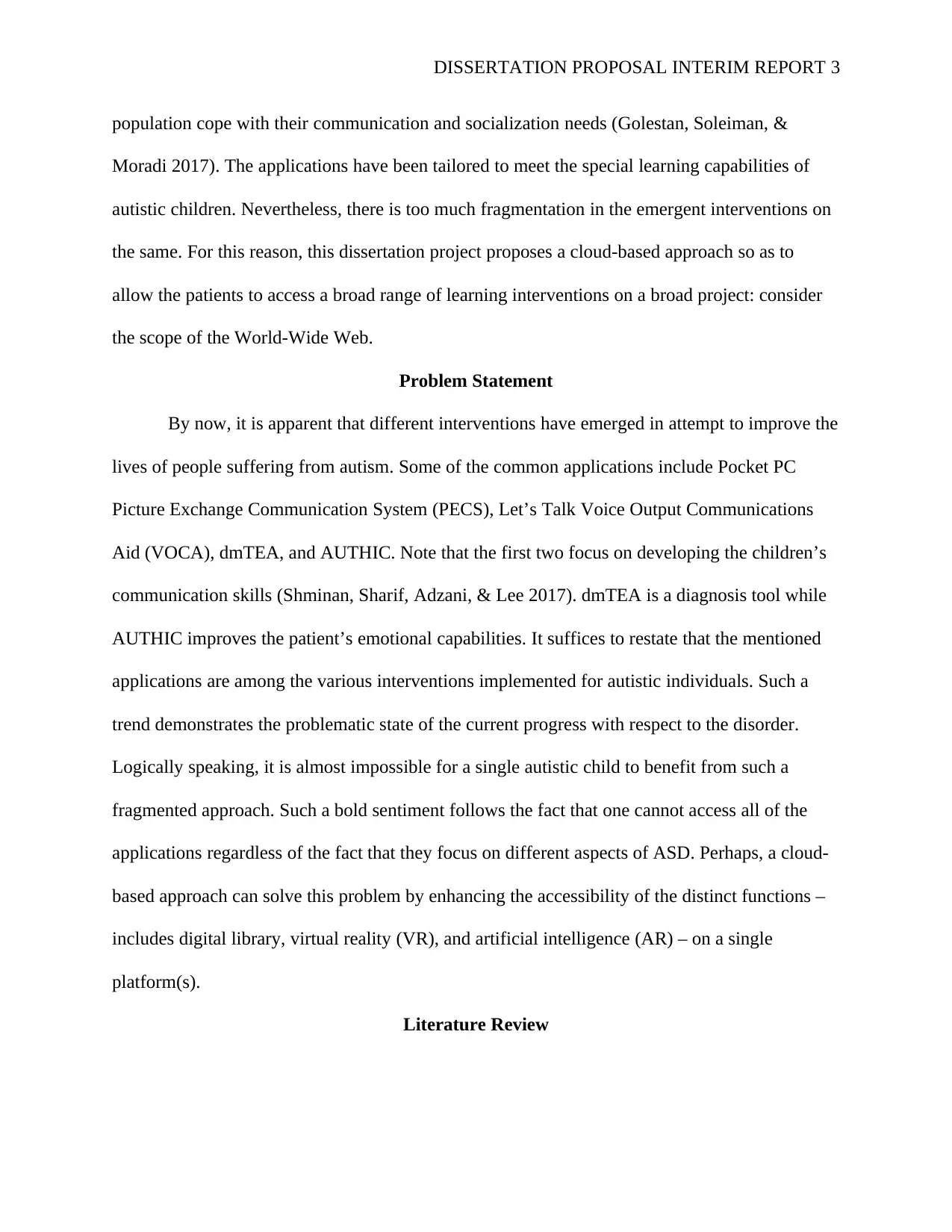
DISSERTATION PROPOSAL INTERIM REPORT 3
population cope with their communication and socialization needs (Golestan, Soleiman, &
Moradi 2017). The applications have been tailored to meet the special learning capabilities of
autistic children. Nevertheless, there is too much fragmentation in the emergent interventions on
the same. For this reason, this dissertation project proposes a cloud-based approach so as to
allow the patients to access a broad range of learning interventions on a broad project: consider
the scope of the World-Wide Web.
Problem Statement
By now, it is apparent that different interventions have emerged in attempt to improve the
lives of people suffering from autism. Some of the common applications include Pocket PC
Picture Exchange Communication System (PECS), Let’s Talk Voice Output Communications
Aid (VOCA), dmTEA, and AUTHIC. Note that the first two focus on developing the children’s
communication skills (Shminan, Sharif, Adzani, & Lee 2017). dmTEA is a diagnosis tool while
AUTHIC improves the patient’s emotional capabilities. It suffices to restate that the mentioned
applications are among the various interventions implemented for autistic individuals. Such a
trend demonstrates the problematic state of the current progress with respect to the disorder.
Logically speaking, it is almost impossible for a single autistic child to benefit from such a
fragmented approach. Such a bold sentiment follows the fact that one cannot access all of the
applications regardless of the fact that they focus on different aspects of ASD. Perhaps, a cloud-
based approach can solve this problem by enhancing the accessibility of the distinct functions –
includes digital library, virtual reality (VR), and artificial intelligence (AR) – on a single
platform(s).
Literature Review
population cope with their communication and socialization needs (Golestan, Soleiman, &
Moradi 2017). The applications have been tailored to meet the special learning capabilities of
autistic children. Nevertheless, there is too much fragmentation in the emergent interventions on
the same. For this reason, this dissertation project proposes a cloud-based approach so as to
allow the patients to access a broad range of learning interventions on a broad project: consider
the scope of the World-Wide Web.
Problem Statement
By now, it is apparent that different interventions have emerged in attempt to improve the
lives of people suffering from autism. Some of the common applications include Pocket PC
Picture Exchange Communication System (PECS), Let’s Talk Voice Output Communications
Aid (VOCA), dmTEA, and AUTHIC. Note that the first two focus on developing the children’s
communication skills (Shminan, Sharif, Adzani, & Lee 2017). dmTEA is a diagnosis tool while
AUTHIC improves the patient’s emotional capabilities. It suffices to restate that the mentioned
applications are among the various interventions implemented for autistic individuals. Such a
trend demonstrates the problematic state of the current progress with respect to the disorder.
Logically speaking, it is almost impossible for a single autistic child to benefit from such a
fragmented approach. Such a bold sentiment follows the fact that one cannot access all of the
applications regardless of the fact that they focus on different aspects of ASD. Perhaps, a cloud-
based approach can solve this problem by enhancing the accessibility of the distinct functions –
includes digital library, virtual reality (VR), and artificial intelligence (AR) – on a single
platform(s).
Literature Review
⊘ This is a preview!⊘
Do you want full access?
Subscribe today to unlock all pages.

Trusted by 1+ million students worldwide
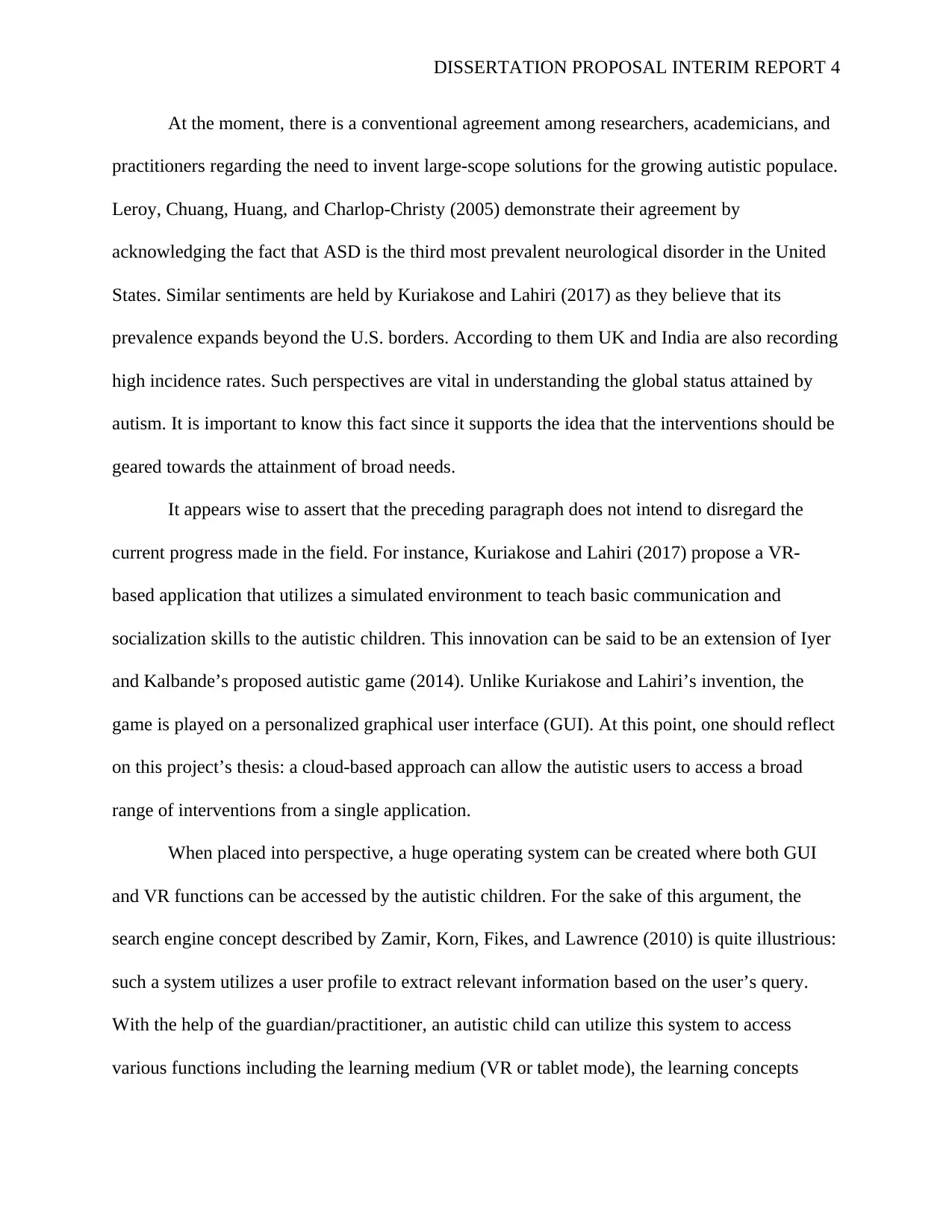
DISSERTATION PROPOSAL INTERIM REPORT 4
At the moment, there is a conventional agreement among researchers, academicians, and
practitioners regarding the need to invent large-scope solutions for the growing autistic populace.
Leroy, Chuang, Huang, and Charlop-Christy (2005) demonstrate their agreement by
acknowledging the fact that ASD is the third most prevalent neurological disorder in the United
States. Similar sentiments are held by Kuriakose and Lahiri (2017) as they believe that its
prevalence expands beyond the U.S. borders. According to them UK and India are also recording
high incidence rates. Such perspectives are vital in understanding the global status attained by
autism. It is important to know this fact since it supports the idea that the interventions should be
geared towards the attainment of broad needs.
It appears wise to assert that the preceding paragraph does not intend to disregard the
current progress made in the field. For instance, Kuriakose and Lahiri (2017) propose a VR-
based application that utilizes a simulated environment to teach basic communication and
socialization skills to the autistic children. This innovation can be said to be an extension of Iyer
and Kalbande’s proposed autistic game (2014). Unlike Kuriakose and Lahiri’s invention, the
game is played on a personalized graphical user interface (GUI). At this point, one should reflect
on this project’s thesis: a cloud-based approach can allow the autistic users to access a broad
range of interventions from a single application.
When placed into perspective, a huge operating system can be created where both GUI
and VR functions can be accessed by the autistic children. For the sake of this argument, the
search engine concept described by Zamir, Korn, Fikes, and Lawrence (2010) is quite illustrious:
such a system utilizes a user profile to extract relevant information based on the user’s query.
With the help of the guardian/practitioner, an autistic child can utilize this system to access
various functions including the learning medium (VR or tablet mode), the learning concepts
At the moment, there is a conventional agreement among researchers, academicians, and
practitioners regarding the need to invent large-scope solutions for the growing autistic populace.
Leroy, Chuang, Huang, and Charlop-Christy (2005) demonstrate their agreement by
acknowledging the fact that ASD is the third most prevalent neurological disorder in the United
States. Similar sentiments are held by Kuriakose and Lahiri (2017) as they believe that its
prevalence expands beyond the U.S. borders. According to them UK and India are also recording
high incidence rates. Such perspectives are vital in understanding the global status attained by
autism. It is important to know this fact since it supports the idea that the interventions should be
geared towards the attainment of broad needs.
It appears wise to assert that the preceding paragraph does not intend to disregard the
current progress made in the field. For instance, Kuriakose and Lahiri (2017) propose a VR-
based application that utilizes a simulated environment to teach basic communication and
socialization skills to the autistic children. This innovation can be said to be an extension of Iyer
and Kalbande’s proposed autistic game (2014). Unlike Kuriakose and Lahiri’s invention, the
game is played on a personalized graphical user interface (GUI). At this point, one should reflect
on this project’s thesis: a cloud-based approach can allow the autistic users to access a broad
range of interventions from a single application.
When placed into perspective, a huge operating system can be created where both GUI
and VR functions can be accessed by the autistic children. For the sake of this argument, the
search engine concept described by Zamir, Korn, Fikes, and Lawrence (2010) is quite illustrious:
such a system utilizes a user profile to extract relevant information based on the user’s query.
With the help of the guardian/practitioner, an autistic child can utilize this system to access
various functions including the learning medium (VR or tablet mode), the learning concepts
Paraphrase This Document
Need a fresh take? Get an instant paraphrase of this document with our AI Paraphraser
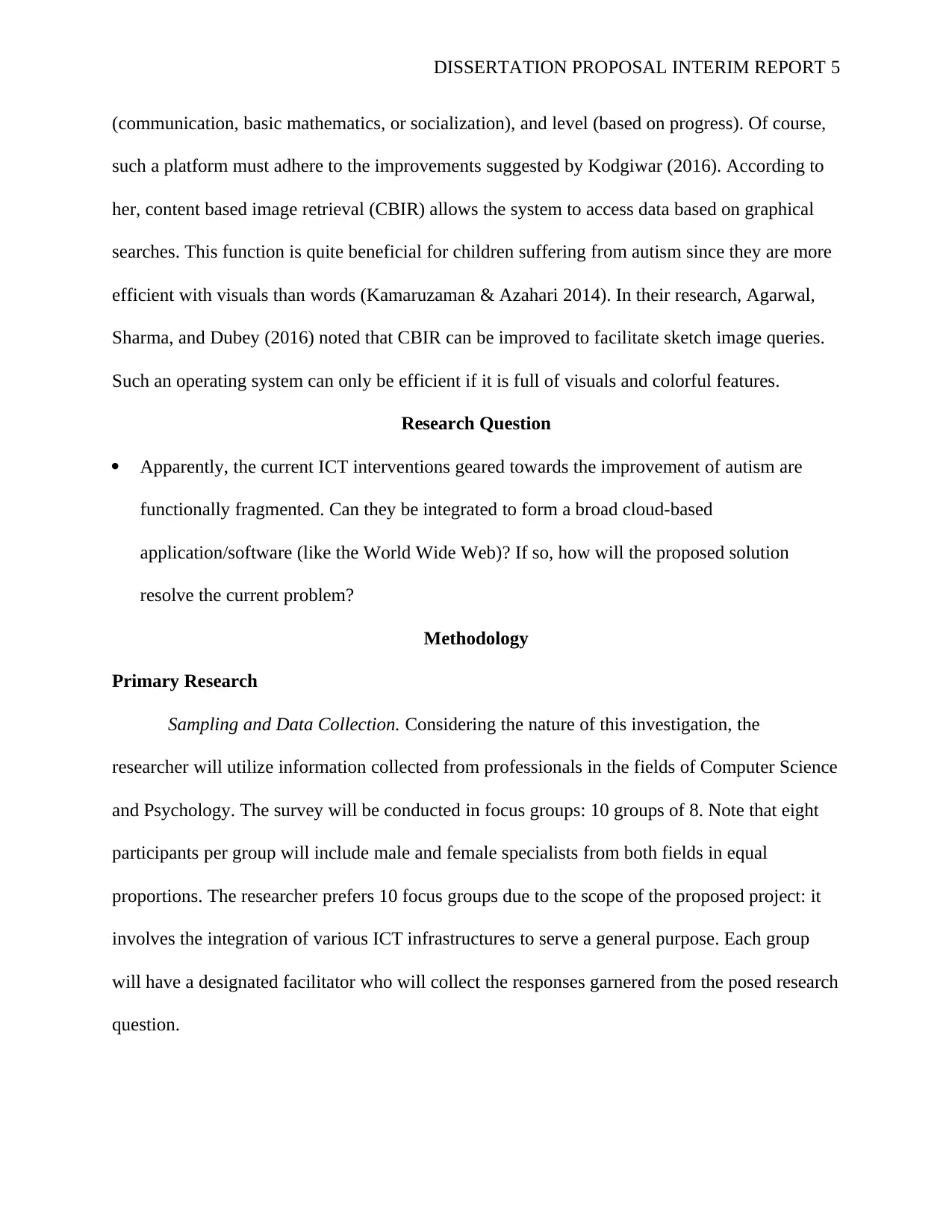
DISSERTATION PROPOSAL INTERIM REPORT 5
(communication, basic mathematics, or socialization), and level (based on progress). Of course,
such a platform must adhere to the improvements suggested by Kodgiwar (2016). According to
her, content based image retrieval (CBIR) allows the system to access data based on graphical
searches. This function is quite beneficial for children suffering from autism since they are more
efficient with visuals than words (Kamaruzaman & Azahari 2014). In their research, Agarwal,
Sharma, and Dubey (2016) noted that CBIR can be improved to facilitate sketch image queries.
Such an operating system can only be efficient if it is full of visuals and colorful features.
Research Question
Apparently, the current ICT interventions geared towards the improvement of autism are
functionally fragmented. Can they be integrated to form a broad cloud-based
application/software (like the World Wide Web)? If so, how will the proposed solution
resolve the current problem?
Methodology
Primary Research
Sampling and Data Collection. Considering the nature of this investigation, the
researcher will utilize information collected from professionals in the fields of Computer Science
and Psychology. The survey will be conducted in focus groups: 10 groups of 8. Note that eight
participants per group will include male and female specialists from both fields in equal
proportions. The researcher prefers 10 focus groups due to the scope of the proposed project: it
involves the integration of various ICT infrastructures to serve a general purpose. Each group
will have a designated facilitator who will collect the responses garnered from the posed research
question.
(communication, basic mathematics, or socialization), and level (based on progress). Of course,
such a platform must adhere to the improvements suggested by Kodgiwar (2016). According to
her, content based image retrieval (CBIR) allows the system to access data based on graphical
searches. This function is quite beneficial for children suffering from autism since they are more
efficient with visuals than words (Kamaruzaman & Azahari 2014). In their research, Agarwal,
Sharma, and Dubey (2016) noted that CBIR can be improved to facilitate sketch image queries.
Such an operating system can only be efficient if it is full of visuals and colorful features.
Research Question
Apparently, the current ICT interventions geared towards the improvement of autism are
functionally fragmented. Can they be integrated to form a broad cloud-based
application/software (like the World Wide Web)? If so, how will the proposed solution
resolve the current problem?
Methodology
Primary Research
Sampling and Data Collection. Considering the nature of this investigation, the
researcher will utilize information collected from professionals in the fields of Computer Science
and Psychology. The survey will be conducted in focus groups: 10 groups of 8. Note that eight
participants per group will include male and female specialists from both fields in equal
proportions. The researcher prefers 10 focus groups due to the scope of the proposed project: it
involves the integration of various ICT infrastructures to serve a general purpose. Each group
will have a designated facilitator who will collect the responses garnered from the posed research
question.
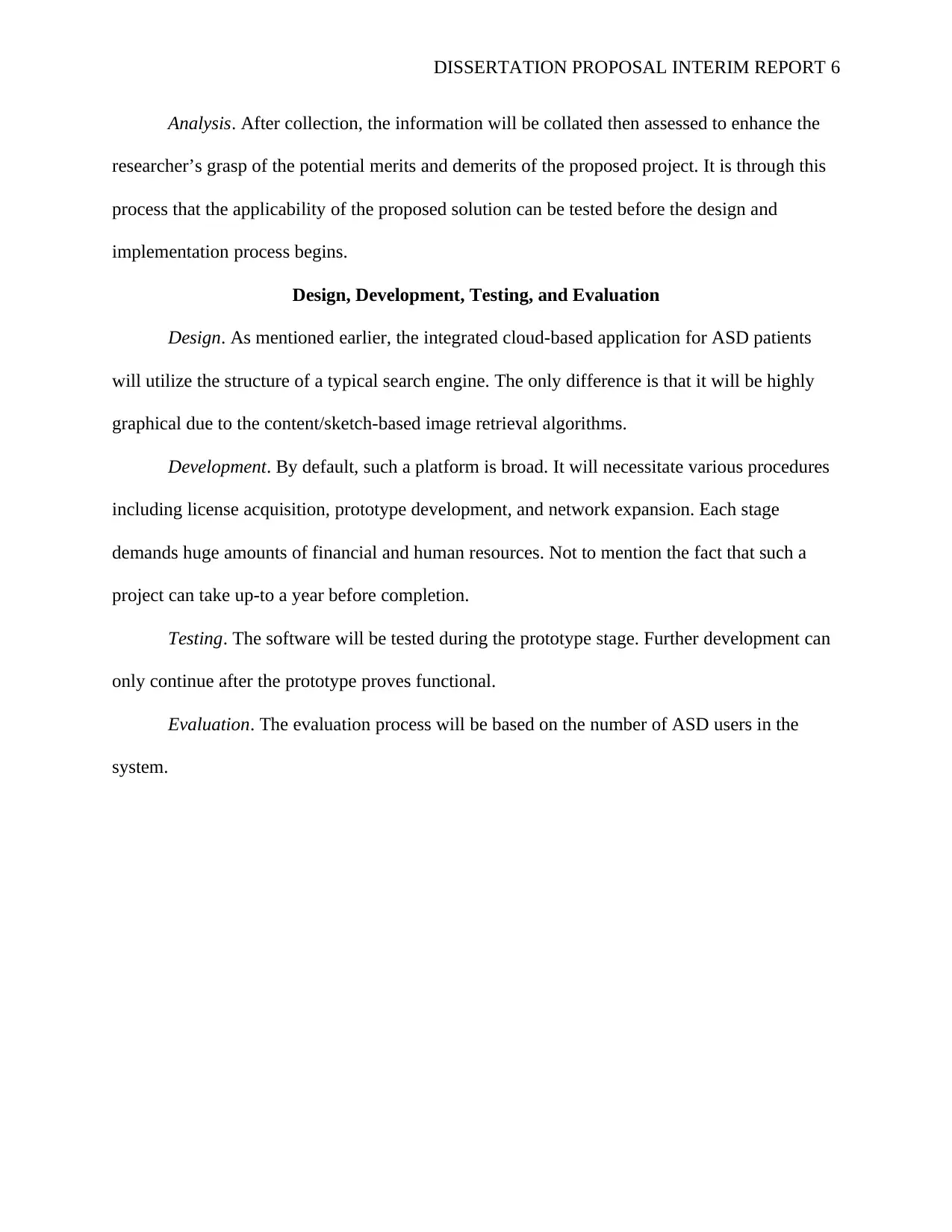
DISSERTATION PROPOSAL INTERIM REPORT 6
Analysis. After collection, the information will be collated then assessed to enhance the
researcher’s grasp of the potential merits and demerits of the proposed project. It is through this
process that the applicability of the proposed solution can be tested before the design and
implementation process begins.
Design, Development, Testing, and Evaluation
Design. As mentioned earlier, the integrated cloud-based application for ASD patients
will utilize the structure of a typical search engine. The only difference is that it will be highly
graphical due to the content/sketch-based image retrieval algorithms.
Development. By default, such a platform is broad. It will necessitate various procedures
including license acquisition, prototype development, and network expansion. Each stage
demands huge amounts of financial and human resources. Not to mention the fact that such a
project can take up-to a year before completion.
Testing. The software will be tested during the prototype stage. Further development can
only continue after the prototype proves functional.
Evaluation. The evaluation process will be based on the number of ASD users in the
system.
Analysis. After collection, the information will be collated then assessed to enhance the
researcher’s grasp of the potential merits and demerits of the proposed project. It is through this
process that the applicability of the proposed solution can be tested before the design and
implementation process begins.
Design, Development, Testing, and Evaluation
Design. As mentioned earlier, the integrated cloud-based application for ASD patients
will utilize the structure of a typical search engine. The only difference is that it will be highly
graphical due to the content/sketch-based image retrieval algorithms.
Development. By default, such a platform is broad. It will necessitate various procedures
including license acquisition, prototype development, and network expansion. Each stage
demands huge amounts of financial and human resources. Not to mention the fact that such a
project can take up-to a year before completion.
Testing. The software will be tested during the prototype stage. Further development can
only continue after the prototype proves functional.
Evaluation. The evaluation process will be based on the number of ASD users in the
system.
⊘ This is a preview!⊘
Do you want full access?
Subscribe today to unlock all pages.

Trusted by 1+ million students worldwide
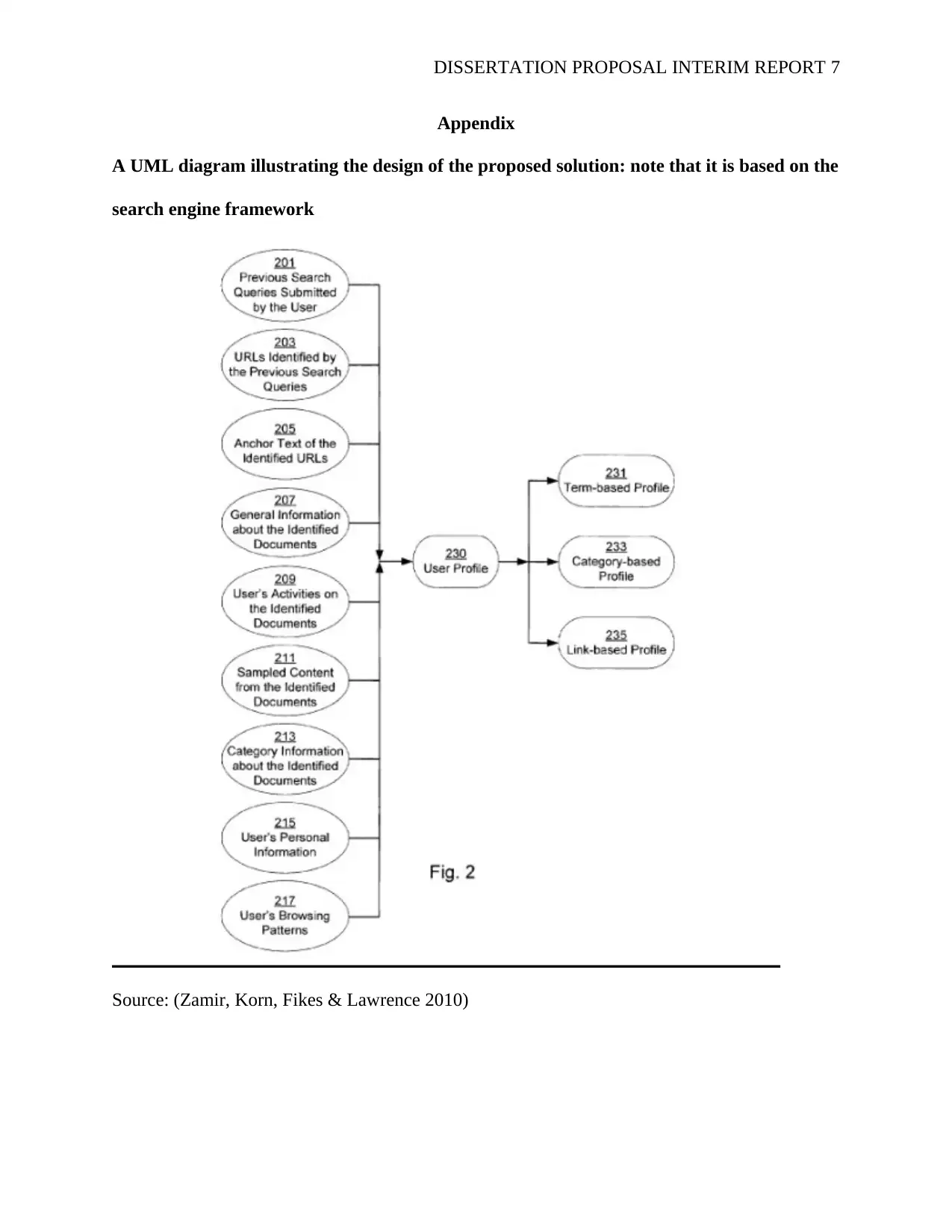
DISSERTATION PROPOSAL INTERIM REPORT 7
Appendix
A UML diagram illustrating the design of the proposed solution: note that it is based on the
search engine framework
Source: (Zamir, Korn, Fikes & Lawrence 2010)
Appendix
A UML diagram illustrating the design of the proposed solution: note that it is based on the
search engine framework
Source: (Zamir, Korn, Fikes & Lawrence 2010)
Paraphrase This Document
Need a fresh take? Get an instant paraphrase of this document with our AI Paraphraser
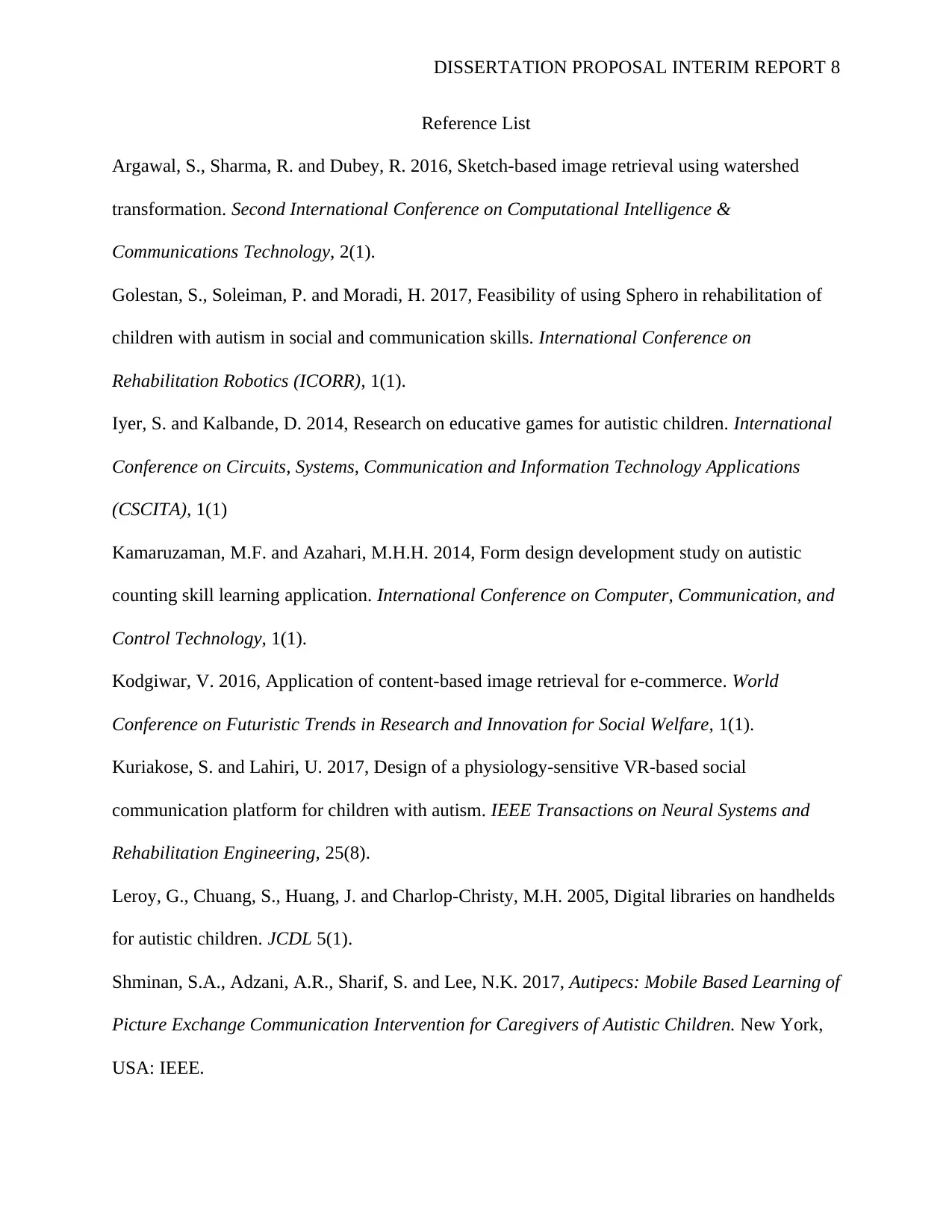
DISSERTATION PROPOSAL INTERIM REPORT 8
Reference List
Argawal, S., Sharma, R. and Dubey, R. 2016, Sketch-based image retrieval using watershed
transformation. Second International Conference on Computational Intelligence &
Communications Technology, 2(1).
Golestan, S., Soleiman, P. and Moradi, H. 2017, Feasibility of using Sphero in rehabilitation of
children with autism in social and communication skills. International Conference on
Rehabilitation Robotics (ICORR), 1(1).
Iyer, S. and Kalbande, D. 2014, Research on educative games for autistic children. International
Conference on Circuits, Systems, Communication and Information Technology Applications
(CSCITA), 1(1)
Kamaruzaman, M.F. and Azahari, M.H.H. 2014, Form design development study on autistic
counting skill learning application. International Conference on Computer, Communication, and
Control Technology, 1(1).
Kodgiwar, V. 2016, Application of content-based image retrieval for e-commerce. World
Conference on Futuristic Trends in Research and Innovation for Social Welfare, 1(1).
Kuriakose, S. and Lahiri, U. 2017, Design of a physiology-sensitive VR-based social
communication platform for children with autism. IEEE Transactions on Neural Systems and
Rehabilitation Engineering, 25(8).
Leroy, G., Chuang, S., Huang, J. and Charlop-Christy, M.H. 2005, Digital libraries on handhelds
for autistic children. JCDL 5(1).
Shminan, S.A., Adzani, A.R., Sharif, S. and Lee, N.K. 2017, Autipecs: Mobile Based Learning of
Picture Exchange Communication Intervention for Caregivers of Autistic Children. New York,
USA: IEEE.
Reference List
Argawal, S., Sharma, R. and Dubey, R. 2016, Sketch-based image retrieval using watershed
transformation. Second International Conference on Computational Intelligence &
Communications Technology, 2(1).
Golestan, S., Soleiman, P. and Moradi, H. 2017, Feasibility of using Sphero in rehabilitation of
children with autism in social and communication skills. International Conference on
Rehabilitation Robotics (ICORR), 1(1).
Iyer, S. and Kalbande, D. 2014, Research on educative games for autistic children. International
Conference on Circuits, Systems, Communication and Information Technology Applications
(CSCITA), 1(1)
Kamaruzaman, M.F. and Azahari, M.H.H. 2014, Form design development study on autistic
counting skill learning application. International Conference on Computer, Communication, and
Control Technology, 1(1).
Kodgiwar, V. 2016, Application of content-based image retrieval for e-commerce. World
Conference on Futuristic Trends in Research and Innovation for Social Welfare, 1(1).
Kuriakose, S. and Lahiri, U. 2017, Design of a physiology-sensitive VR-based social
communication platform for children with autism. IEEE Transactions on Neural Systems and
Rehabilitation Engineering, 25(8).
Leroy, G., Chuang, S., Huang, J. and Charlop-Christy, M.H. 2005, Digital libraries on handhelds
for autistic children. JCDL 5(1).
Shminan, S.A., Adzani, A.R., Sharif, S. and Lee, N.K. 2017, Autipecs: Mobile Based Learning of
Picture Exchange Communication Intervention for Caregivers of Autistic Children. New York,
USA: IEEE.

DISSERTATION PROPOSAL INTERIM REPORT 9
Teevan, J., Dumais, S. and Horvitz, E. 2017, Personalizing search via automated analysis of
interests and activities. ACM SIGIR Forum, 51(3).
Zamir, O.O., Korn, J.L., Fikes, A.B. and Lawrence, S.R. 2010, United States Patent. Patent No.
7693827B2.
Teevan, J., Dumais, S. and Horvitz, E. 2017, Personalizing search via automated analysis of
interests and activities. ACM SIGIR Forum, 51(3).
Zamir, O.O., Korn, J.L., Fikes, A.B. and Lawrence, S.R. 2010, United States Patent. Patent No.
7693827B2.
⊘ This is a preview!⊘
Do you want full access?
Subscribe today to unlock all pages.

Trusted by 1+ million students worldwide
1 out of 9
Related Documents
Your All-in-One AI-Powered Toolkit for Academic Success.
+13062052269
info@desklib.com
Available 24*7 on WhatsApp / Email
![[object Object]](/_next/static/media/star-bottom.7253800d.svg)
Unlock your academic potential
Copyright © 2020–2025 A2Z Services. All Rights Reserved. Developed and managed by ZUCOL.




